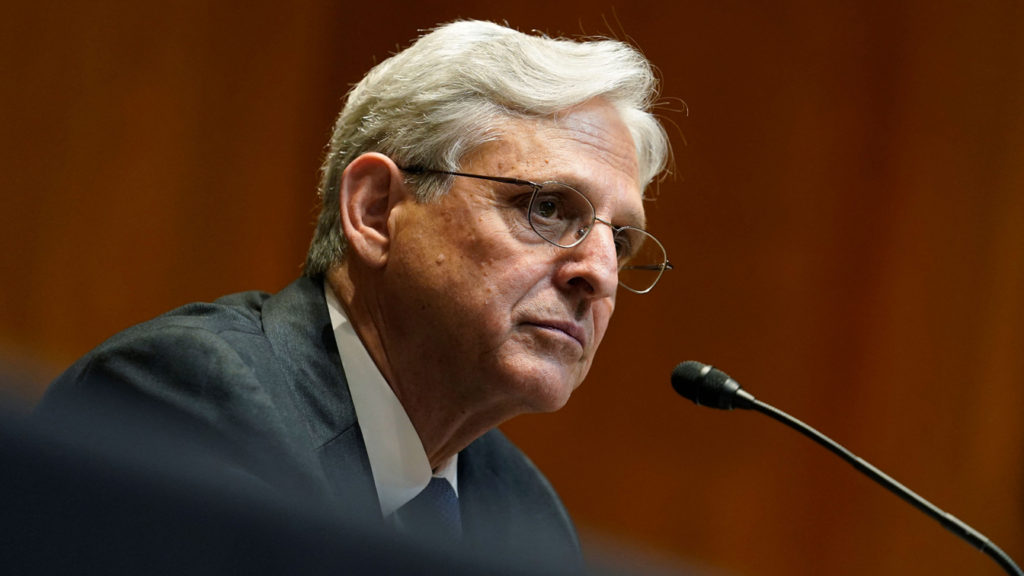[ad_1]
Attorney General Merrick Garland told a Senate subcommittee Wednesday that a majority of federal inmates have been at least partially vaccinated for COVID-19, while the bulk of Federal Bureau of Prisons officers have also received at least one dose of a vaccine.
“As of right now, at least 52 percent [of inmates] have received at least one vaccine dose,” Garland told Senate lawmakers. “With respect to the Bureau of Prisons Staff, 100 percent have been offered vaccines. Fifty-one percent are fully vaccinated, and another 661 in addition to that have received their first vaccine dose.”
While the percentage of federal inmates who have been vaccinated is higher than in the American population at large (49.2 percent of Americans have received at least one dose), the number is still too low to put a standstill on the spread of COVID-19 among the prison population.
Since the start of the pandemic, incarcerated people have been hit by COVID-19 at higher rates than the general population, with prisons, jails and detention centers reporting infection rates more than five times higher than the nation’s overall rate, as well as higher death rates from the disease.
Attorney General Merrick Garland testifies before a Senate Appropriations subcommittee on Wednesday. (Susan Walsh/AFP via Getty Images)
Overcrowded, cramped living conditions found in correctional institutions make it extremely difficult to prevent the spread of COVID-19. The prison population is also more vulnerable to infection than the general population thanks to a growing number of older (55-plus) inmates, the age group most likely to face serious complications from COVID-19.
Critics have alleged that prison officials made the situation more dangerous for inmates by failing to take precautionary measures such as purchasing adequate PPE or strictly enforcing mask wearing and social distancing practices.
Chris Beyrer, a professor of public health and human rights at Johns Hopkins University, told Vox that the Maryland Division of Correction is not providing free, unlimited bars of soap to inmates. “We are living through the failure of basic COVID prevention,” he said.
Story continues
According to a report conducted by the California prison system’s Office of the Inspector General, prison staff even loosened protective measures against the spread of COVID-19 there despite an increase in the number of cases among inmates.
Data collected by the Marshall Project shows that from the start of the pandemic to June 4, 2021, there were at least 398,321 cases of COVID-19 and 2,697 deaths reported among incarcerated individuals, and 113,607 cases and 207 deaths among prison staff. The figures, the Marshall Project said, are likely an undercount because “sixteen prison systems are not releasing information about how many prisoners they are testing, including the Federal Bureau of Prisons, which has seen several major outbreaks of coronavirus in its institutions.”
A vial of COVID-19 vaccine is prepared at a mobile clinic in Los Angeles. (Irfan Khan/Los Angeles Times via Getty Images)
Since the rollout of the COVID-19 vaccine in late 2020, the Centers for Disease Control and Prevention has recommended prioritizing prisoners for vaccines. According to Michael Carvajal, the director of the Federal Bureau of Prisons, all federal prisoners should have received the opportunity to be vaccinated by mid-May. However, the vaccine is not mandatory.
“We respect their right to make a choice,” Carvajal said of inmates while testifying before the Senate Judiciary Committee in April.
Despite the severity of the pandemic in prisons, there is significant hesitation among correctional officers and inmates who distrust and fear the possible short- and long-term effects of COVID-19 vaccines. In Iowa, almost half of prison workers have refused to take a vaccine; 30 percent of prisoners and 40 percent of prison workers did the same in Virginia.
There have, however, been a few successful states whose prison vaccination rates are higher than the general public’s. Seventy-four percent of California’s inmates have accepted at least one dose of the vaccine, and Idaho boasts an even higher rate of 92 percent.
The wide disparity between state prison vaccination rates can be attributed in part to how the vaccinations are being introduced and distributed to inmates. Lauren Brinkley-Rubinstein, a professor at the University of North Carolina School of Medicine who leads the Covid Prison Project, a group that has created a database to provide recent statistics on COVID-19 within correctional facilities, emphasized the importance of education in creating more acceptance toward vaccinations.
San Quentin State Prison in California. (Justin Sullivan/Getty Images)
“Especially in a prison context, where there tends to be a lot of distrust of both health care staff and correctional staff, that education piece becomes even more important,” Brinkley-Rubinstein told the New York Times.
Rhode Island is another state where prison staff and inmates are lining up to get the vaccine. Dr. Justin Berk, medical director of the state’s Department of Corrections, said it has made an effort to encourage inoculations “through our educational campaigning … and through a lot of outreach efforts” like videos, information packets and education sessions.
Emily Wang, a professor at the Yale School of Medicine, expressed her disappointment with the overall statistic to the New York Times: “If the best estimates are 50 percent, I’ll bet it’s lower. And we’re not close to the mark. There’s no question in my mind, this hasn’t gone well.”
While the rate of inmate vaccination touted by Garland may not be promising yet, a few states have shown, through their educational efforts and vaccination programs, that there is still promise in decelerating the outbreak of COVID-19 within America’s prisons.
____
Read more from Yahoo News:
[ad_2]
Source link
